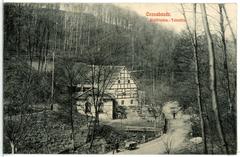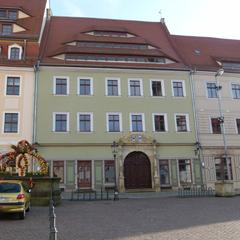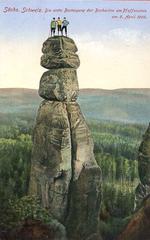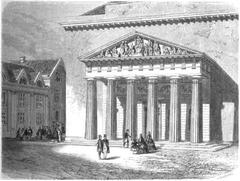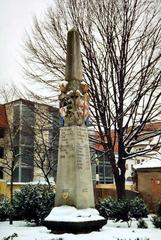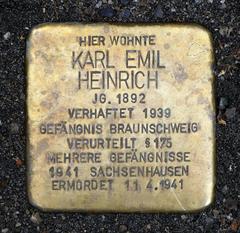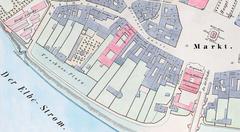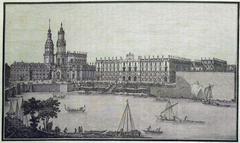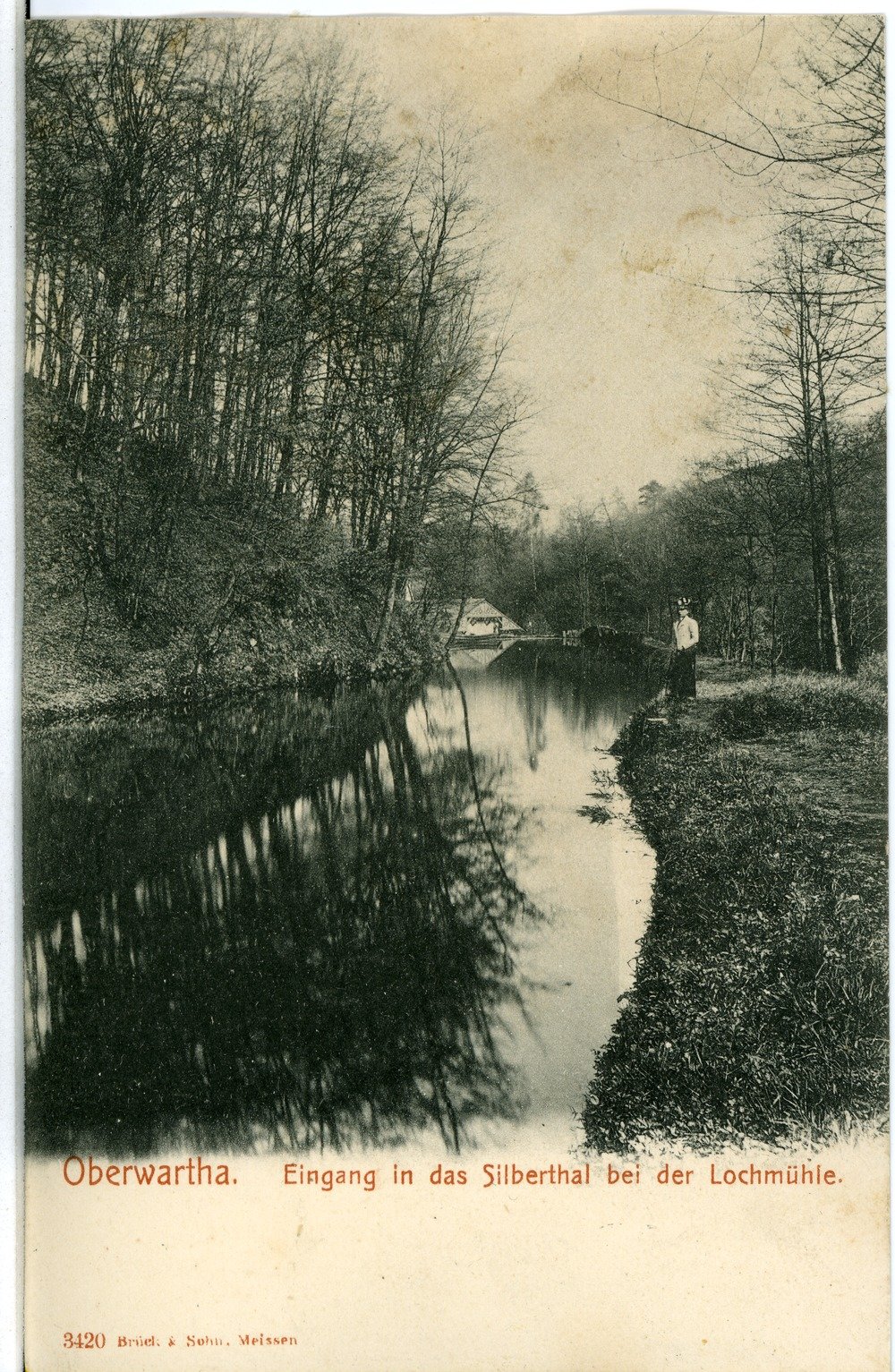
Visiting Lochmühle: Hours, Tickets, and Travel Tips in Pirna, Germany
Date: 01/08/2024
Introduction
Nestled in the picturesque Wesenitztal within the Saxon Switzerland region, Lochmühle in Pirna, Germany, is a historical gem that beckons travelers with its fascinating blend of history, culture, and natural beauty. First mentioned in records in 1559, this mill has journeyed through centuries, witnessing significant transformations and events that have shaped its current state (Wikipedia). From surviving rockfalls and fires to becoming a beloved guesthouse frequented by notable figures like Richard Wagner, Lochmühle has been a silent witness to the ebb and flow of time (Wikipedia). Today, despite its state of abandonment, efforts are underway to preserve and potentially restore this cultural landmark, ensuring its stories are not lost to history (Komoot). This guide aims to provide you with a comprehensive overview of Lochmühle’s historical significance, visitor information, and practical travel tips to enhance your visit to this unique site.
Table of Contents
- Introduction
- Historical Background
- Visitor Information
- Best Time to Visit
- Weather Considerations
- Safety Tips
- Accommodation and Travel Costs
- Local Attractions
- Transportation
- Local Cuisine
- Language and Communication
- Currency and Payments
- Health and Safety
- Local Etiquette
- Emergency Contacts
- Useful Apps and Resources
- Ticket Prices
- Opening Hours
- Special Events
- Guided Tours
- Photographic Spots
- FAQ
- Conclusion
Historical Background
Early History and Establishment
The Lochmühle, located in the Wesenitztal within the Saxon Switzerland region, has a rich history dating back to the mid-16th century. The mill was first mentioned in historical records in 1559 as a “Mahlmühle” (grist mill). The construction of the mill likely occurred shortly before this date, as the records indicate that the mill was not yet fully completed at the time of its first mention (Wikipedia).
Rebuilding and Relocation
In 1681, a significant rockfall destroyed the original mill structure. Consequently, the mill was rebuilt approximately 30 steps upstream from its initial location. This relocation was necessary to ensure the safety and functionality of the mill in the face of the unstable geological conditions of the area (Wikipedia).
Development as a Tourist Attraction
By the late 18th century, the Lochmühle began to gain prominence as a tourist destination. The mill’s picturesque setting in the Liebethaler Grund, a narrow gorge carved by the Wesenitz River through the Elbe Sandstone Mountains, made it an attractive spot for visitors. The mill’s remote location, accessible only by steep paths and stairways from nearby villages such as Mühlsdorf and Daube, added to its allure (Wikipedia).
Transition to a Guesthouse
In 1828, the Lochmühle was destroyed by fire but was promptly rebuilt by its then-owner, Friedrich August Schreiter. The new structure included four grinding mills. In 1842, Schreiter received permission to operate a guesthouse within the mill. This development marked the beginning of the mill’s transformation into a popular destination for artists, poets, and composers. Notably, Richard Wagner visited the mill several times in the summer of 1846 and composed parts of his opera there (Wikipedia).
Integration into the Tourist Infrastructure
The Lochmühle played a crucial role in the early tourist infrastructure of the Saxon Switzerland region. Before the completion of the Elbtalbahn railway in 1851, the route from Pillnitz through Graupa and the Lochmühle to Lohmen and the Bastei was the primary access route to the region. The mill served as the “western gateway” to the Saxon Switzerland, offering visitors their first encounter with the area’s wild and romantic sandstone formations (Wikipedia).
19th and 20th Century Developments
Throughout the 19th century, the Lochmühle continued to develop as a tourist attraction. In 1820, the steep path from the mill to Daube was improved, and in 1841, a new hiking trail was established from Liebethal to the mill. This trail was extended in 1882 to connect with the next mill upstream, the Daubemühle, further enhancing the accessibility and attractiveness of the Wesenitztal for tourists (Wikipedia).
Decline and Abandonment
Despite its historical significance and popularity, the Lochmühle fell into disuse in the early 1990s. The mill has remained vacant since then, and its condition has deteriorated over the years. Efforts to restore and repurpose the mill have been proposed, including plans announced in 2015 to integrate the mill into a new hotel development. These plans included the construction of a panoramic elevator to connect the hotel on the plateau above the Wesenitztal with the Lochmühle. However, the project’s completion remains uncertain, and the site continues to appear abandoned (Komoot).
Cultural and Artistic Significance
The Lochmühle holds a special place in the cultural and artistic history of the region. It is part of the Dichter-Musiker-Maler-Weg (Poet-Musician-Painter Trail) and the Malerweg (Painter’s Way), which are hiking trails that celebrate the artistic heritage of the Saxon Switzerland. The mill and its surroundings have been depicted in numerous historical illustrations, capturing the area’s natural beauty and romantic charm (Wikipedia).
Modern Efforts and Future Prospects
In recent years, there have been efforts to stabilize and preserve the Lochmühle. In March 2017, safety measures were undertaken to address the risk of collapse, including the removal of the unstable roof and its replacement with a temporary structure. These efforts are part of ongoing attempts to secure the site and explore potential future uses for the historic mill (Wikipedia).
Visitor Information
Visiting Hours
Lochmühle is accessible year-round, but specific visiting hours may vary. It’s advisable to check the official website for up-to-date information (Lochmühle).
Tickets
Entry to the site is free, but guided tours may have associated costs. Contact local tourism offices for detailed pricing.
Special Events
Keep an eye out for special events and guided tours that may be offered during your visit.
Travel Tips
- Wear comfortable hiking shoes.
- Carry water.
- Be prepared for steep paths and stairways.
- Bring a camera to capture scenic views.
Nearby Attractions
Consider visiting other historical sites and natural landmarks in the Saxon Switzerland region, such as the Bastei rock formation and Königstein Fortress (Sächsische Schweiz).
Accessibility
The area may be challenging for visitors with mobility issues due to its steep terrain.
Best Time to Visit
The optimal time to visit Lochmühle in Pirna is from June 4th to September 23rd when the weather is most favorable.
Weather Considerations
- Spring (March-May): Moderate cold with highs ranging from 65°F to 39.3°F.
- Summer (June-August): Comfortably cool, with highs around 84.2°F.
- Fall (September-November): Highs ranging from 67.5°F to 40.1°F.
- Winter (December-February): Too cold for warm-weather travelers, with highs between 50°F and 29.9°F.
Safety Tips
Pirna is considered somewhat safe for tourists, but it is advisable to exercise a high degree of caution due to travel warnings for Germany as of December 2023.
Accommodation and Travel Costs
The busiest months for tourism in Pirna are October, January, and August, with peak prices. December offers the lowest prices for accommodations and flights.
Local Attractions
- Historical Sites: Gothic and Baroque architecture.
- Natural Beauty: Fairytale forests and alpine villages.
- Cultural Experiences: Museums, festivals, and the arts scene (Pirna).
Transportation
Pirna is accessible by train, bus, and car. The nearest major airport is Dresden Airport. From there, you can take a train or rent a car to reach Pirna.
Local Cuisine
- Sauerbraten: Pot roast, usually of beef.
- Bratwurst: German sausage made from pork, beef, or veal.
- Pretzels: Baked bread product.
Language and Communication
While German is the official language, many locals speak English. Learning basic German phrases can enhance your experience.
Currency and Payments
Germany uses the Euro (€). Credit and debit cards are widely accepted, but it’s advisable to carry some cash for smaller establishments.
Health and Safety
Ensure you have travel insurance that covers health emergencies. Carry any necessary medications and a basic first aid kit.
Local Etiquette
- Greetings: A firm handshake is standard. Address people by their titles and last names until invited to use their first names.
- Tipping: A tip of 5-10% is generally appreciated in restaurants and for other services.
- Public Behavior: Germans value punctuality and orderliness.
Emergency Contacts
- Police: 110
- Fire Department: 112
- Medical Emergency: 112
Useful Apps and Resources
- Google Maps: For navigation and finding local attractions.
- Duolingo: For learning basic German phrases.
- TripAdvisor: For reviews and recommendations.
- DB Navigator: For train schedules and ticket bookings.
FAQ
What are the visiting hours for Lochmühle?
Lochmühle is generally open from 9 AM to 6 PM during the peak season, but hours may vary (Lochmühle).
How much do tickets to Lochmühle cost?
Ticket prices vary, with discounts available for children, students, and seniors. Refer to the official website for current pricing.
Are there guided tours available at Lochmühle?
Yes, guided tours are available and recommended. They can be booked in advance online or at the visitor center.
What should I bring when visiting Lochmühle?
Wear comfortable hiking shoes, carry water, and bring a camera to capture the scenic views. If you plan to use the grill huts, make sure to reserve early.
Are there any nearby attractions to visit?
Yes, you can explore other historical sites and natural landmarks in the Saxon Switzerland region, such as the Bastei rock formation and Königstein Fortress (Sächsische Schweiz).
Conclusion
The Lochmühle in Pirna, Germany, stands as a testament to the region’s rich historical and cultural tapestry. From its early days as a grist mill in the mid-16th century to its transformation into a guesthouse beloved by artists and composers, the mill has played a pivotal role in the local heritage (Wikipedia). Its picturesque setting in the Liebethaler Grund, part of the Saxon Switzerland National Park, offers not just a journey through history but also a chance to immerse in nature’s beauty (Sächsische Schweiz). Despite its current state of disuse, ongoing preservation efforts and potential future developments hint at a promising revival. Whether you’re a history buff, nature enthusiast, or cultural explorer, Lochmühle promises a memorable and enriching experience. Plan your visit today and explore the myriad stories that this remarkable site has to offer.



